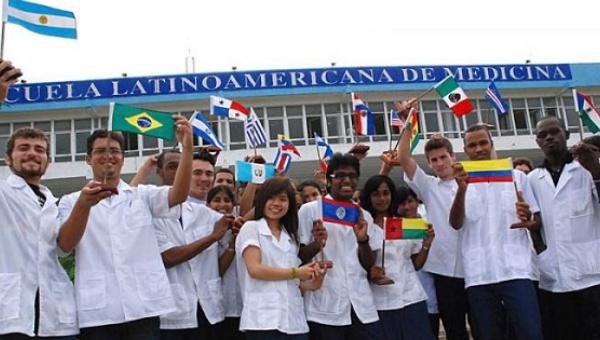The Latin American Medical School
Morning Star | Monday, 24 December 2018 | Click here for original article

IN HAVANA, written on a wall there is a slogan accredited to young communists: “Amor es la major ley” (love is the best law). What would you give to live in a society where love is proclaimed as the best law? Words like “love thy neighbour as thyself” are often spoken at this time of year but it is Cuba that provides an example the like of which the world has never seen before.
In 1998 when Hurricane Mitch devastated Nicaragua and Honduras, Cuba immediately sent medical personnel to help. But instead of just short-term emergency relief Cubans pointed out that “the permanent hurricane of poverty and underdevelopment kills more people every year than these hurricanes just did…”
Many of those treated had never seen a doctor before so Cuba came up with its own version of the “teach a person to fish” story. They immediately set about transforming a naval academy on Cuba’s north coast, just west of Havana, into the Latin American School of Medicine (ELAM) and it was officially opened by Raul Castro a few months later in March 1999.
A bus loaded with Nicaraguans was the first to arrive and six months later 1,932 medical students were enrolled on a six-year degree. Eladio Garcia Valcarcel, one of the school’s founders, said: “Fidel said that this was a school to train doctors for the whole world.” Having previously taught at the military academy he told me that now: “I would no longer prepare young people for war, but to heal the world.”
Ten years later Dr Margaret Chan, director-general of the World Health Organisation said during a visit to the school: “I know of no other medical school that offers students so much, at no charge. I know of no other medical school with an admissions policy that gives first priority to candidates who come from poor communities and know, first-hand, what it means to live without access to essential medical care. For once, if you are poor, female, or from an indigenous population you have a distinct advantage. This is an institutional ethic that makes this medical school unique.”
The school quickly grew to include students from 30 nations of Africa and the Americas, and has now included students from more than 120 countries. Five years ago when visiting the school in Cuba former UN secretary-general Ban Ki Moon said Cuba gives us a lesson of solidarity and generosity.
“We are all one, brothers and humans. Human health must stop being the privilege of the few to become the law for many,” he stressed. Ban Ki Moon also congratulated the students of ELAM which ranked as “the most advanced medical school in the world.”
In 2019 ELAM will celebrate the 20th anniversary of its first intake of students with a commitment to continue training women and men of science and conscience to contribute from Cuba to the unity and integration of nations. With the current number of students surpassing 7,000 from 24 countries of Latin America and the United States, the school held its 15th graduation in 2018, in which young people from all continents received their diplomas after achieving outstanding results.
As Fidel Castro stated at its inauguration on November 15 1999, the school is dedicated to the noblest and most humane of professions, saving lives and preserving health: “More than doctors, they will be the most precious guardians of human beings; apostles and creators of a more humane world.”
This article, by Bob Oram, featured in the Morning Star special 60th Anniversary of the Cuban Revolution edition






